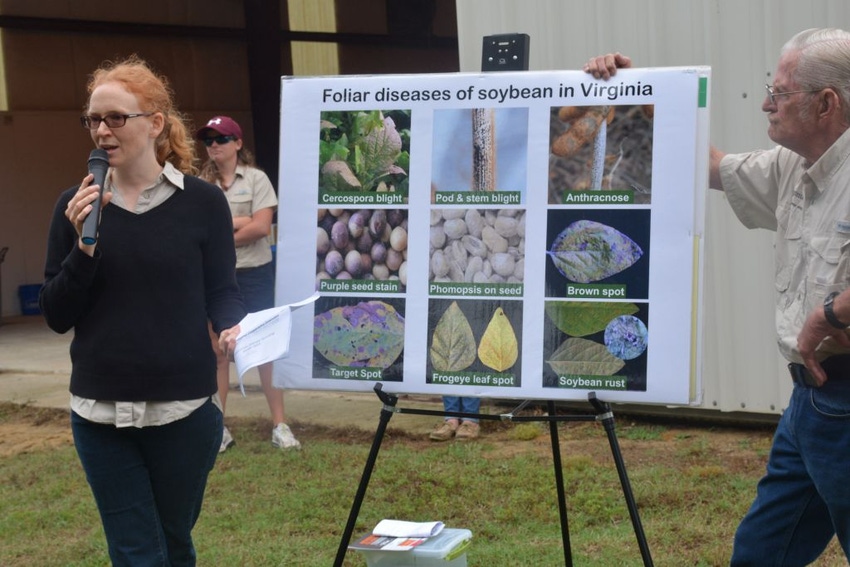
Variety selection plays an important role in reducing risk to diseases in field crops.
“Often times, if a proper variety is selected, you can forego some fungicide applications,” said Hillary Mehl, Virginia Cooperative Extension plant pathologist, at the Early Summer Row Crops Tour at the Tidewater Agricultural Research Farm in Suffolk, Va. June 4.
Mehl stressed that knowing the specific pathogen is very important. “We have some diseases that are more damaging than others. It is important to know what disease you’re dealing with when you decide what approach you’re going to take with management,” she said.
For most of the foliar fungal diseases, moderate temperatures and moisture through high humidity or rain drives the development of diseases in corn, cotton, peanuts and soybeans, she explained.
“Different management practices that may or not be effective for different diseases include crop rotation, host resistance, varieties, seed treatments and foliar fungicides,” she said. “Not all diseases can be controlled in-season with a foliar fungicide, and this is important to keep in mind because if you use a fungicide, you need it to control specific diseases, but if it doesn’t reach your target, it’s going to be a waste of time and money.”
Mehl said selecting the proper chemistry is important. “You need to know what disease you have, but you’re not going to know unless someone actually goes out into the fields and scouts for these diseases,” she stressed.
In soybeans, most foliar fungicides do a good job of controlling such diseases as Cercospora Blight and Frogeye Leaf Spot, according to Mehl. “However, over the past couple of years throughout the Southeast, people have been finding that Frogeye Leaf Spot is resistant to Strobilurin mode of action fungicides,” she said.
“Last year, in two locations in Virginia we confirmed resistance to Strobilurin. We are planning on conducting a statewide survey this year. This is important because we may change our fungicide recommendations if the Strobilurin mode of action isn’t working for this disease any more. It may be necessary to switch to a different mode of action or a mixture of modes of action if Strobilurin won’t control the disease in soybean fields.”
Disease management in peanuts includes crop rotation, host resistance, infurrow, fungicides, seed treatment fungicides, foliar fungicides and fumigation, according to Mehl.
“Fumigation in the past has been common for control for CBR (Cylindrocladium black rot) and nematodes,” she added. “We have several varieties now that have quite good resistance to CBR. If a resistant variety such as Bailey is planted and there is a good rotation in the field, there is really no need to fumigate unless potentially there is a really bad nematode problem in that field.”
For cotton, Corynespora target spot is a concern and has the potential to cause yield loss, Mehl said. “In our trials in Virginia, the impact on yield has been very inconsistent. It really depends on when in the season the disease comes in and how quickly it develops,” she explained. “If you go further south in Georgia, you see a lot more yield loss than we see in Virginia.”
Foliar fungicides are recommended more in Georgia for control of target spot in cotton than in Virginia. “If you see this disease developing early on, there may be some benefit to a fungicide, but in general this disease hasn’t been very detrimental to cotton in Virginia,” she said.
Some other foliar diseases in cotton indicate nutrient deficiencies and aren’t typically controlled with fungicides, Mehl said. For example, Cercospora leaf spot, Stemphyllium leaf spot and Cercospora leaf spot are not controlled by foliar fungicides. “It’s important to know the differences in these diseases to know what approach to take to manage them,” Mehl said.
For corn diseases, whether or not you need a foliar fungicide depends on how early the disease shows up and what the disease is. “It is important to know the growth stage of your crop and to scout,” Mehl said.
Scouting is particularly important for farmers who are trying to minimize input costs due to lower crop prices. “For growers who are concerned about saving money, scouting is the way to go in figuring out the best way to control diseases,” Mehl said.
About the Author(s)
You May Also Like






